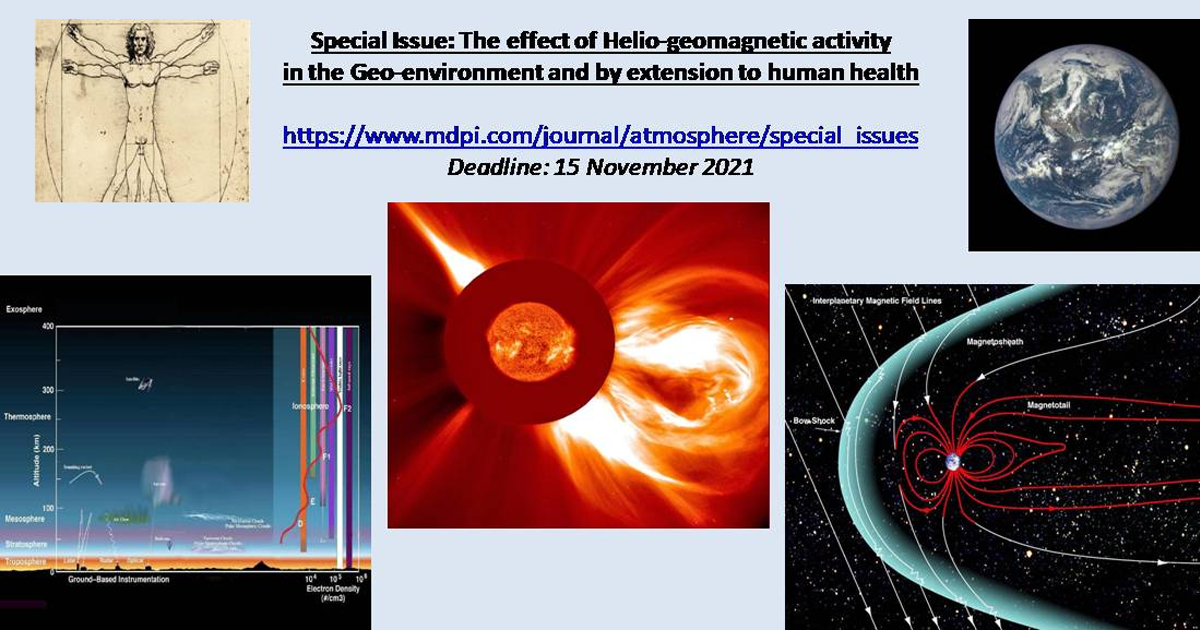The Effect of Helio-Geomagnetic Activity in the Geo-Environment and by Extension to Human Health
A special issue of Atmosphere (ISSN 2073-4433). This special issue belongs to the section "Upper Atmosphere".
Deadline for manuscript submissions: closed (15 November 2021) | Viewed by 39370

Special Issue Editors
Interests: solar physics; solar- terrestrial relations; helio-geomagnetic activity; planets; archaeoastronomy
Interests: climate dynamics; climate physics; climate change and variability; aerosols; ambient air quality; ozone-climate interactions; atmospheric physics and chemistry; nonlinear processes; artificial intelligence and machine learning; remote sensing
Special Issues, Collections and Topics in MDPI journals
Special Issue Information
Dear Colleagues,
Solar activity includes the eruptive phenomena of the solar atmosphere: flares and Coronal Mass Ejections (CMEs). These events are spread through the Sun’s constant outflow of solar wind, influencing the very nature of interplanetary space, and can interact with the terrestrial magnetophere. As a consequence, energetic particles, waves and radiation, derived from the solar atmosphere, reach the geo-environment. Geomagnetic substorms or storms, as well as ionospheric disturbances, are recorded. Climatic parameters of the upper atmosphere are affected too. The effect of this helio-geomagnetic activity on human technology, e.g., in the operation of artificial satellites, on air flights, in electricity networks and gas pipelines, is well known, as well as its effect on the health of astronauts, either on the space station or space travel to the Moon and Mars. Many studies have been done on the impact of these events on weather and climate. However, the question remains open, although some correlation has been found between solar activity and various climatic factors. It seems that the biosphere is also affected by these events, as effects have been found on the evolution of some plants and the behavior of some animals. Moreover, many medical studies have shown the effect of the helio-geomagnetic activity on human health, with an emphasis on neurological and cardiological problems.
The purpose of the present Special Issue is the collection and classification of as many studies as possible on these subjects. This will give future researchers the opportunity to access aggregate results, and therefore make it easier to continue research on this topic, which is related to the very existence of life on earth.
Main topics:
- The effect of helio-geomagnetic activity in the Atmosphere–Ionosphere
- The effect of helio-geomagnetic activity on human health
- The effect of helio-geomagnetic activity in the biosphere
Dr. Panagiota Preka-Papadema
Dr. Chris G. Tzanis
Guest Editors
Manuscript Submission Information
Manuscripts should be submitted online at www.mdpi.com by registering and logging in to this website. Once you are registered, click here to go to the submission form. Manuscripts can be submitted until the deadline. All submissions that pass pre-check are peer-reviewed. Accepted papers will be published continuously in the journal (as soon as accepted) and will be listed together on the special issue website. Research articles, review articles as well as short communications are invited. For planned papers, a title and short abstract (about 100 words) can be sent to the Editorial Office for announcement on this website.
Submitted manuscripts should not have been published previously, nor be under consideration for publication elsewhere (except conference proceedings papers). All manuscripts are thoroughly refereed through a single-blind peer-review process. A guide for authors and other relevant information for submission of manuscripts is available on the Instructions for Authors page. Atmosphere is an international peer-reviewed open access monthly journal published by MDPI.
Please visit the Instructions for Authors page before submitting a manuscript. The Article Processing Charge (APC) for publication in this open access journal is 2400 CHF (Swiss Francs). Submitted papers should be well formatted and use good English. Authors may use MDPI's English editing service prior to publication or during author revisions.
Keywords
- solar activity
- geomagnetic storms
- ionospheric disturbances
- climatic changes
- human health






